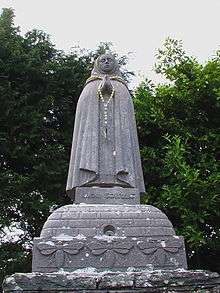Seamus Murphy
Seamus Murphy, (15 July 1907 – 2 October 1975) was an Irish sculptor and stone carver, best known for designing the Church of the Annunciation, Blackpool, Cork. Examples of his unique carvings of statues, gravestones, monuments and plaques can be seen around Cork and Ireland, including a signed panel of the four evangelists outside the entrance of the church of Our Lady and Saint John in Carrigaline, Co. Cork.

Life
The birth of James (Seamus) Murphy, and that of his twin brother John, is recorded at Fair Street, Mallow, County Cork, on 15 July 1907.[1] His father, James Murphy, was a railway employee.[2]
The 1911 census records the family, now with two further sons (Michael, b. 1909 and Bartholomew 5 days old when the census was taken on 2 April), living on Ballyhooley Road in Cork city.[3]
He attended Saint Patrick's School on Gardiner's Hill and, after finishing his full-time schooling at the age of twelve, found work as an apprentice sculptor. He would, in time, go on to become a Royal Hibernian Academy professor of sculpture. In 1944 he married Maighread Higgins, daughter of the Cork sculptor Joseph Higgins, and they went on to have three children; the knitwear designer Bebhinn Marten, the novelist Orla Murphy and the painter and De Dannan member Colm Murphy. His studio/workshop was at Watercourse Road, Blackpool, Cork.
See also
- List of public art in Cork
References
- Colette Sheridan (6 November 2014). "Cork Film Festival: Seamus Murphy has a reputation set in stone".
- Murphy, Seamus (2005). Stone mad. illustrations by William Harrington. Wilton, Cork: Collins Press. ISBN 978-1903464816.